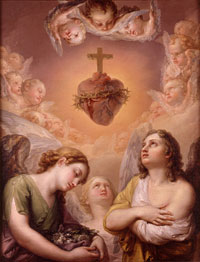Easter traditions and origins
[ 2006-04-14 20:26 ]
|
瞧,“春之女神”抱着她的小兔子向您招手了,很难想象吧?基督教最古老最有意义的一个节日,实际上是以古代北欧的黎明女神“伊奥斯特”命名的。伊奥斯特,原意是指“冬日逝去后春天的太阳从东方升起”,由于该词喻意“新生”,于是被基督教教徒借用,期冀“光明的恩赐者耶稣再次回到人间”。 |
|
|
Easter traditions and symbols are abundant. But what are the
origins of these Easter traditions? Learn the history of Easter traditions
here.
 The Easter Season The Easter Season
Easter is not only a holiday but a season unto itself. To many
religious people, it marks a time of miracles and a reaffirming of faith.
To those with a more secular view of the world, it is a celebration of the
end of winter, a time to look toward the warmth of the coming summer and a
chance to shed the heavy clothing of the winter for the bright colors of
spring.
 The Date of Easter
(April 16, 2006) The Date of Easter
(April 16, 2006)
 |
|
Goddess of
the spring | Easter is a movable
holiday, which is calculated as the first Sunday after the full
moon that occurs on or after the vernal
equinox. If the full moon falls on a Sunday, then Easter
is the following Sunday. The holiday can occur anywhere between March 22
and April 25. This year Easter is April 16, 2006.
 The pagan oigins Of
Easter The pagan oigins Of
Easter
Long before Easter became the holiday it is today,
the spring festival was celebrated by the people around the world. The
celebration was originally based on the lunar calendar. The name Easter is
derived from the Saxon Eostre
(which is synonymous with the name of the Phoenician Goddess of the Moon,
Astartephoto), a
Germanic goddess of spring and the deity who measured
time.
 The Christian origins of
Easter The Christian origins of
Easter
"For God so loved the world
that He gave His only Son, so that everyone who believes in Him will not
perish but have eternal life. God did not send His Son into the world to
condemn it, but to save it" (John 3:16-17).
As Christianity grew and spread throughout the world, it was common
practice to adopt, modify, convert or take over existing non-Christian
festivals. Because Eostre was the goddess of spring and her symbolism
dealt with renewal and rebirth, the Christian belief in the resurrection
of Christ fit well with these themes.
** The Easter story of Jesus (photo
)
 |
|
Angels
Adoring the Heart of Jesus, by Vicente Lopez
Portana | On Good Friday , Jesus Christ was executed by
crucifixion. His body was taken down from the cross, and buried in a cave.
The tomb was guarded and an enormous stone was put over the entrance, so
that no-one could steal the body.
On the following Sunday, some women visited the grave and found that
the stone had been moved, and that the tomb was empty. Jesus himself was
seen that day, and for days afterwards by many people. His followers
realised that God had raised Jesus from the dead.
** The Easter Vigil Service (15 April 2006
)
The Easter Vigil service
(photo) is
the first Easter service, and takes place on the night of Holy Saturday.
Holy Saturday is the Saturday after Good Friday which is often, but
wrongly, called Easter Saturday.
The idea behind the service is for faithful Christians to wait and
watch, hopeful and confident that Christ will return at midnight.
The Easter candle (photos) is
lit during this service. The service traditionally begins outside the
church, where minister and some worshippers gather around a fire - a
charcoal brazier is common.
The service begins with words like these:
Brothers and sisters in Christ, on this most holy
night, in which our Lord Jesus Christ passed over from death to life, the
Church invites her members, dispersed throughout the world, to gather in
vigil and prayer.
After being lit outside, the candle is carried into the church, where
most of the worshippers are waiting in darkness, which symbolises the
darkness of Christ's tomb.
(英语点津陈蓓编辑) |
|
|
| Vocabulary:
|
| |
|
vernal equinox: 春分
Eostre:
伊奥斯特,撒克逊黎明女神。它的原意是指“冬日逝去后春天的太阳从东方升起,把新生命带回”。由于该词喻意“新生”,于是被基督教教徒借用过来表示光明的恩赐者耶稣再次回到人间。
Phoenician:
腓尼基人的,生活于叙利亚沿岸
Astarte:
阿斯塔蒂,腓尼基人所崇拜的丰饶女神,传统上掌管爱情和生育。
The Easter Vigil
Service:
复活节守夜礼,在复活前夕,教会守夜不眠、等待着基督的复活,并以圣事来庆祝。守夜礼分四个主要部分:烛光礼,圣道礼,洗礼,圣祭礼。
Good
Friday: the Friday before Easter, observed by Christians in
commemoration of the crucifixion of
Jesus(耶稣受难日,复活节前的星期五,被基督教徒作为耶稣受难节予以纪念) |
|